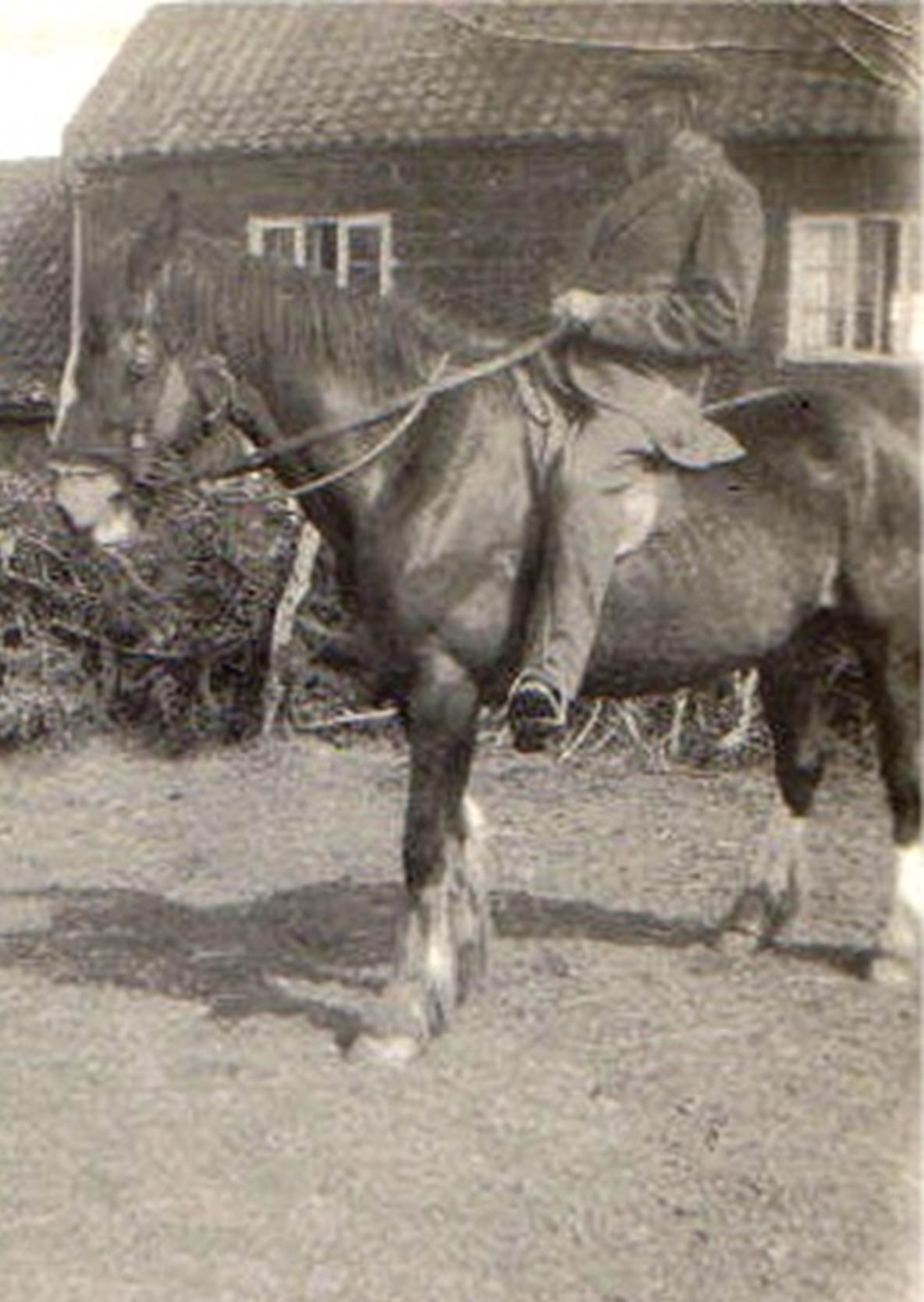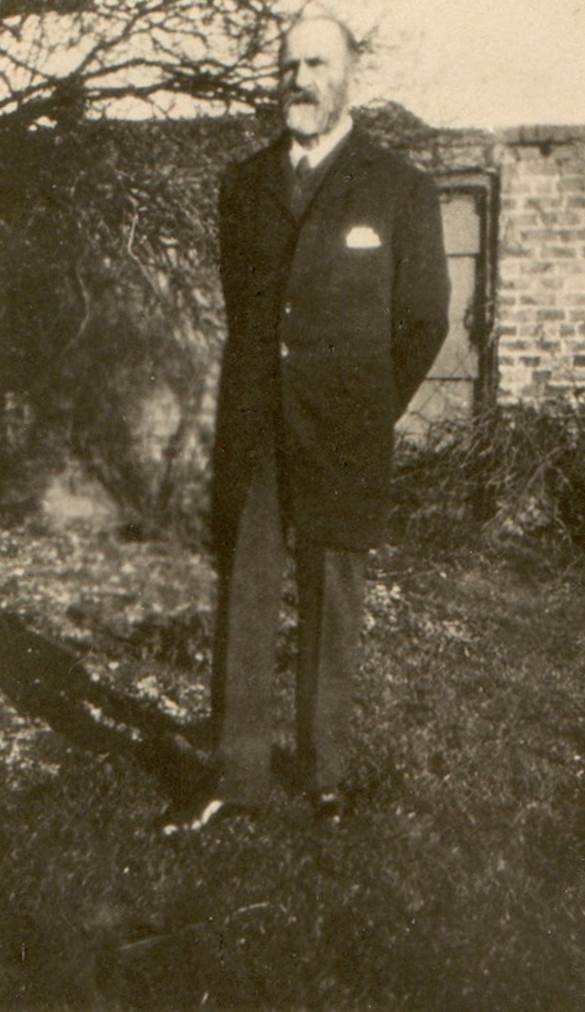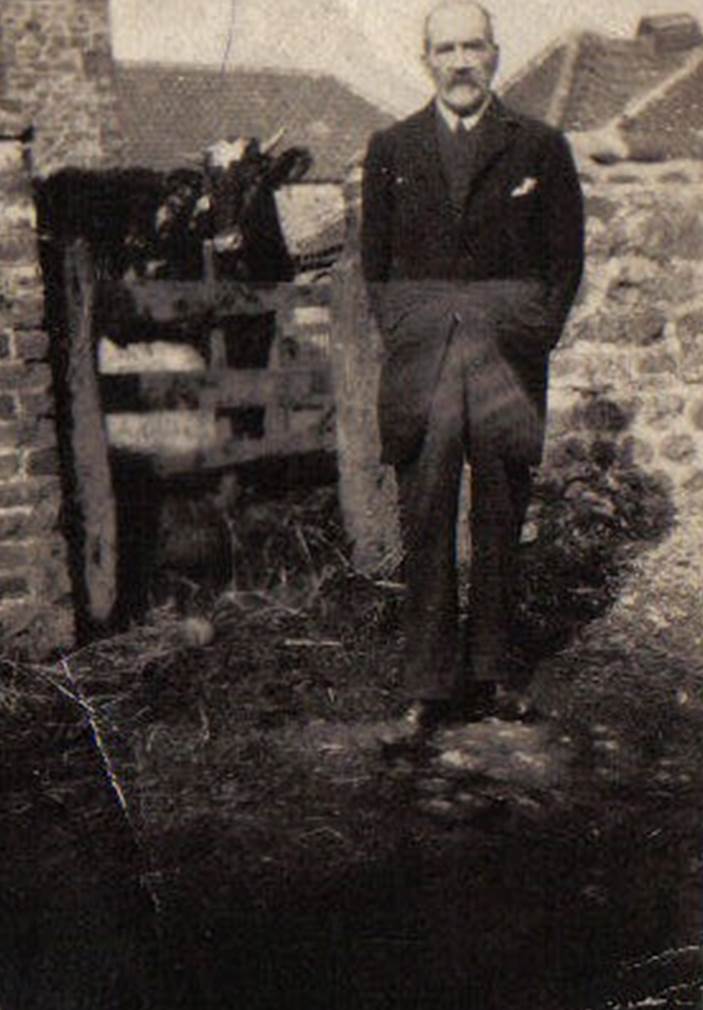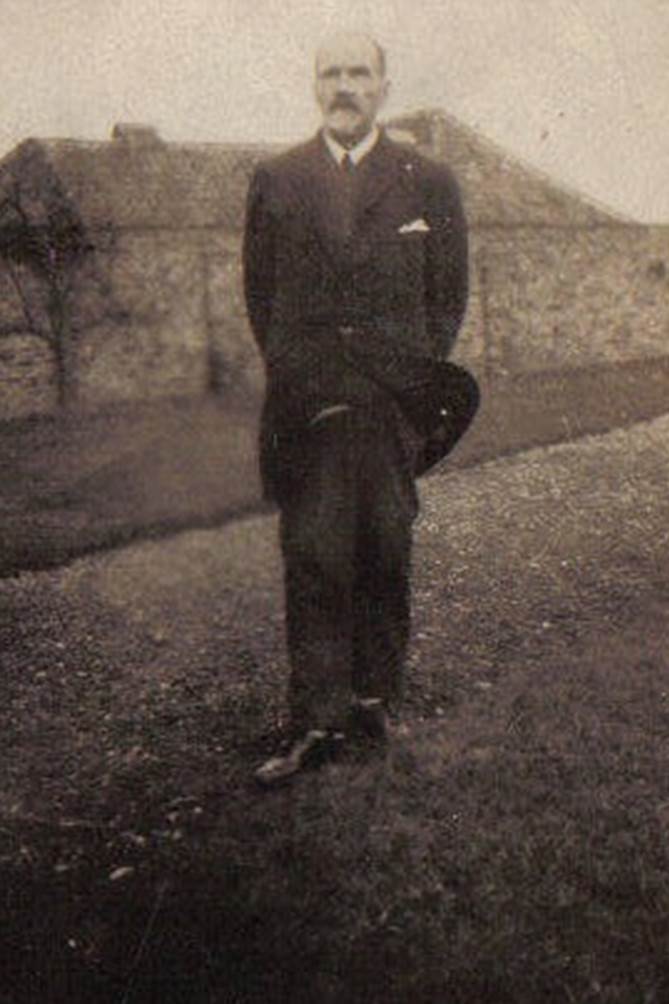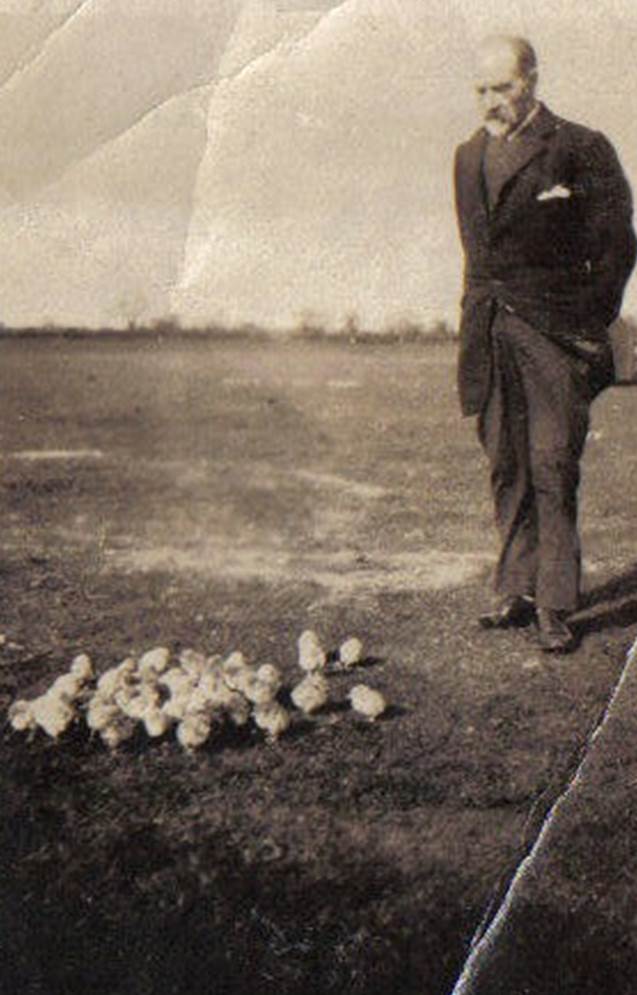19 September 1845 to 17 January 1928


FAR00364
|
Return to the Home
Page of the Farndale Family Website |
The story of one
family’s journey through two thousand years of British History |
The 83 family lines
into which the family is divided. Meet the whole family and how the wider
family is related |
Members of the
historical family ordered by date of birth |
Links to other pages
with historical research and related material |
The story of the
Bakers of Highfields, the Chapmans, and other related families |
Farmer of Tidkinhow
Dates are in red.
Hyperlinks to
other pages are in dark
blue.
Headlines of
Martin’s life are in brown.
References and
citations are in turquoise.
Context and local
history are in purple.
1845
Martin Farndale, was born
at Fogga Farm near Skelton
on 19 September 1845 the son of Martin and Elizabeth (nee Taylor)
Farndale (FAR00264), a farmer of Fogga. He was baptised on 20 October 1845 (Skelton PR). He was he was
aged 5 and born at Skelton. Certainly his
birth is recorded in Skelton Parish Register as "Born September 19th 1845 and baptised on
October 20th 1845 as son of Martin Farndale." Although all his brothers
recorded at Somerset House, Martin's birth is not recorded there. The family
consisted of four boys, William (born 1842), Martin (born 1845), John (born
1848) and Matthew (born 1850).

His
father, Martin, was working with James Taylor, his father-in-law. His mother,
Elizabeth (nee Taylor) seems to have been James' only child and heiress
to his farm. Martin was in fact the second son of Martin and Elizabeth.
In the 1913
parish rate book for Skelton in 1913, Fogga was
described as North Skelton and George
Harrison made a will regarding Fogga Farm in 1718
and it was the location of a later ironstone mine, formally called Old Fogga on the 1856 ordnance survey map.



So Fogga farm is where North Skelton (confusingly to the east
of Skelton) now stands.
Martin was
probably sharing an interest with his father in law, James Taylor and was
variously described as the farmer in his own right and a labourer, presumably
working for or with Jame Taylor.
1851
At
the time of the 1851 census the young Martin Farndale was listed is listed as
grandson to the owner of the house he was living in (ie to James Taylor of Fogga). The 1851 Census shows the family
at Skelton- Fogga
Farm comprising James Taylor, head, aged 74, widower, born Barnby, farmer of 70
acres; Elizabeth Farndale, 40, married, daughter of James Taylor, wife of
Martin Farndale, born at Fylingdales; Martin Farndale, 33, married, born Easby,
Son-in-law; William Farndale, son of Martin, aged 8, born Skelton, grandson of
James Taylor (FAR00356).
Martin Farndale, son of Martin Farndale the Elder, aged 5, born Skelton,
grandson of James Taylor (FAR00364);
John Farndale, son of Martin Farndale the Elder, aged 2, born Skelton, grandson
of James Taylor (FAR00376);
and Matthew Farndale, son of Martin Farndale the Elder, aged 9, born Skelton,
grandson of James Taylor (FAR00383).

1854
Martin's
eldest brother died at Skelton, aged 11, of
inflammation of the chest on 29 January 1854. Martin was aged 9 at this time.
He was probably going to
school at Skelton.
1861
The Census of 1861 for 61 Galey Hill, Hutton Lowcross
listed Martin Farndale, head; married; aged 42; agricultural
labourer; born Easby (Martin’s father); Elizabeth Farndale, his wife;
aged 44; born Skelton; John Farndale, son; aged 12; scholar; born Skelton (FAR00376); and Matthew Farndale,
son; aged 10; scholar; born Skelton (FAR00383). Martin Farndale
Junior, who would then have been aged 16, was not listed in the census so
must have been away for some reason.
1862
Martin’s father died at
Guisborough on 12 July 1862 of empyma and at this time Martin was
17. There is a family story that his father had been kicked by a horse.
For the next 14 years it appears that Martin grew
up in the Skelton /Brotton area. He probably went on
working for his maternal grandfather for some time, taking on some
responsibility for looking after his two younger brothers and his mother.
1871
The Census
of 1871 for
Brough House, Brotton recorded John Rigg, head, 47; Martin
Farndale, 25, born 1846, agricultural labourer and four others.

1873
By 1873, Martin Farndale
was an ‘in door farm servant’ but also working in the mines. The
Northern
Echo 11 July 1873: THE
CLEVELAND OWNERS AND MINERS. MR RUPERT KETTLE’S AWARD. JUDGEMENT AGAINST ANY
ADVANCE. We are at length in a position to announce the nature of Mr Rupert
Kettle's award in the dispute between the mine owners and the miners of
Cleveland, one which has been looked forward to with eager interest by all
classes of the community. As a prelude to setting forth the text of this
important award, all we need to do is very briefly to recapitulate some of the
leading features of the dispute referred to. In March last an application
was made by the miners of Cleveland for an advance of 2d per ton upon their
output of ironstone, being equal to about 12% upon the rates then current;
a demand being, at the same time, also made by other classes of work when
employed at the mines, for an increase of 10% in their wages. The masters
replied to the men was that, looking at the advances already given, and the
wages earned, as well as the ability of the men to earn more, they could not
accede to the demand. At this, the Cleveland owners formed themselves into
an Association, upon similar a similar basis to what had in 1872 being done by
the collier owners of the county of Durham...
After
much negotiation and I'm sorry to say, a stoppage of production for a
considerable time in this great mining district, it was agreed, at a meeting of
representatives of miners and mine owners, held on the 28th of may, as follows:
“That it be left to an Arbitrator to determine whether the wages of the
Cleveland miners should be advanced or reduced, and to what extent,
measured by the standard of wages now prevailing in such industries in the
north of England as the Arbitrator may deem it reasonable to consider in making
his award.” The contending parties requested me to undertake the duties of
Arbitrator; And all preliminary arrangements having been made, and the case on
both sides prepared, an Arbitration meeting was commenced at Saltburn on the
23rd of June. Witnesses were examined by each party, and much valuable
information was given on both sides by means of extracts from account books,
and by carefully prepared statistical tables, upon every subject bearing upon
the matter in dispute. At the close of our settings, I was prepared to give my
award; but as trade arbitration law is new to the Cleveland...
There
was also much uncertainty of opinion as to the time which elapses before an
ordinary labourer becomes a thoroughly practical miner.
Upon the main point, however, the workmen's witnesses confirmed, so far as
individual cases can be said to confirm the results of statistics taken over a
wide range, the case made out by the employers. Martin Farndale, an indoor
farm servant seven months ago, was now earning 7s 10d a shift. Richard
Vayro, a farm labourer, after nine months working in the mines, was earning 8s
1d a shift. These were said to be exceptional, because they worked a “Pick
Place”....
The Northern Echo, 25 July 1873: THE
LATE ARBITRATION IN CLEVELAND. To the Editor of the Northern Echo. Sir, will
you kindly allow me space in your paper to say a few words in my defence, in
connection with the late arbitration at Saltburn, as I understand Mr Shepherd
stated at a public meeting at Brotton that if the miners did not get the 2d per
tonne it would be on account of the evidence given by Robert Campbell. It seems
that the part objected to was that I was paying my mate 6s per day, the average
wage in Cleveland being 7s, therefore leaving 8s for me. He contended that this
injured our cause. Now, if the Cleveland miners will read and think for
themselves, they will see that truth did not injure our cause. Mr Shepherd
asserted that our average wage was 5s 11d per day; and the first two witnesses
he called on our side, Mr Farndale and Richard Nayro,
those men but a few months out of a farmyard, the one received 7s 10d per
day, and the other 8s 1d, so that the owners could not have called two better
witnesses on their part. Some say I should not have gone there; neither I
should, but Mr Shepherd sent a messenger to Eston on the Monday evening for the
witnesses, as he said that Mr Lee had asserted that the ironstone miner
could work with his vest on, while the collier worked in a state of nudity,
and the steam rising out of his back was greater than the heaviest explosion of
powder in the mine ...
1874
In December 1874, Martin
Farndale took a tenancy on a small holding. On 1 December 1874 there
was an Assignment of the Lease from George Coates of Lackenby,
yeoman and John Harrison the younger of Darlington in Duham, to Martin
Farndale of Kilton, of a parcel of land 135 square yards and the four
stone houses built on it as marked on the map for the remainder of the term
of 99 years (Reference U/AA/1/38, Teeside Archives.
(being rehoused in the Dorman Museum))
1877
Martin
was clearly continuing to work as a miner as by 1877 Martin was described as a miner of Brotton on
his marriage certificate.
Martin Farndale married
Catherine Jane Lindsay, daughter of Andrew Lindsay, a shoemaker of Darlington, at
St Cuthbert's Church, Darlington on 7 July 1877 (Darlington PR). He
was aged 31 and she was aged 28. The ceremony was witnessed by James Mattison
and Polly Thompson and the service was conducted by the Reverend T E Hodgson
vicar.
Catherine
Lindsey was born at Alnwick, Northumberland on 28 Jul 1854. Her father was a shoemaker
living in Queen's Head Yard, Alnwick. There is more information about her
family at the Lindsey Line.


Catherine
Lindsay on 29 October 1875, shortly before her marriage Catherine’s birth certificate
Martin and Catherine
Farndale had a large family of twelve.
The
story of the family is also told in the
Tidkinhow Line.

Martin, aged 32, about the time of his marriage
It appears that the newly
wedded couple moved to a cottage at Kilton Thorpe.
According to Brotton Parish Register, their eldest son John
was baptised on 17 February 1878 having been born 24 December 1877. He was born
"to Martin and Catherine Jane Farndale of Kilton Thorpe, a miner."
1878
John
Farndale (FAR00553) was born
at Kilton Thorpe on 22 December 1878 and
baptised on 17 February 1879 (GRO Vol 9d page 475, Brotton PR).


1879
Their next child, a daughter, Elizabeth Lindsay Farndale
(FAR00564) was born two years later at Kilton Thorpe on
11 December 1879 and baptised at Brotton on
25 January 1880 (Brotton PR). Martin and Catherine were still living at Kilton Thorpe,
but Martin Farndale was now
described as a farmer.

1881
Their third child, Martin Farndale (FAR00571), was born at Kilton
Thorpe on 8 June 1881 and was baptised at Brotton on 31 July 1881 (Brotton PR) and his parents were still at
Kilton-Thorpe and described as farmers.

The 1881 Census for 2 Kilton Thorpe, Kilton listed Martin Farndale, head,
married, 34, an
ironstone miner; John Farndale, 3 born Kilton 1878; Elizabeth Farndale, 1,
born Kilton 1880.

Sometime
in the next two years Martin moved to Tranmire Farm near Whitby since his next
two children were born there. There is a family story that Martin asked his
brother Matthew to go to make a bid for Craggs Hall Farm near Brotton. The
story goes that Matthew returned saying that he'd taken the farm - for himself! True or not that is where Matthew
went and Martin went to Tranmire, a farm some ten miles along the road to
Whitby - a moor farm near Ugthorpe situated on Roxby Moor. Martin’s
other brother John spent his life working on the railway at Loftus.
It was at Tranmire that their next son
George was born in January 1882 and also their next daughter, Catherine Jane,
named after her mother and always known as Kate; she was born on 16 June 1884.
Tranmire
Farm, near Ugthorpe - Martin and Catherine moved here in or about 1883 from Kilton Thorpe.
George Farndale (FAR00588) was
born at Tranmire on 9 January 1882. His birth was registered in Guisborough
District in the first quarter of 1883 (GRO Vol 9d page 498).

Catherine Jane Farndale (FAR00601) was
born at High Whims Farm, Tranmire on 16 June 1884. She was baptised at Ugthorpe
on 21 April 1885 (Ugthorpe
PR).


The eldest son John recalled driving sheep from
Tranmire to Tidkinhow when seven years old.
The Yorkshire Herald and
York Herald, 28 November 1885: AYSDALEGATE AND TIDKINHOW FARMS, Slapewath, near Guisborough. The Trustees of the late Wm Barningham
are prepared to receive tenants for the letting of the whole of these valuable
Old Grass Land Farms, comprising together about 2300 acres, with all their
buildings. A grand opportunity either for sheep farmers or dairy keepers.
Immediate possession can be given. For particulars apply to JOHN WOODFIELD,
Springfield, Darlington.
By the time James
was born on 22 December 1885, the family had moved to Tidkinhow farm on
Stranghow Moor near Guisborough, an improvement on Tranmire. The young family were brought up at Tidkinhow and the
other six children were born there.
James Farndale (FAR00607) was
born at Tidkinhow Farm
on 22 December 1885. His birth was registered in the first quarter of 1886 (GRO Vol 9d page 493).

1887
William
Farndale (FAR00625) was born
at Tidkinhow Farm on 22 June 1887 and
baptised on 10 August 1887 (Skelton PR), but died only two years later
on 19 July 1889.

1889
Mary
Frances Farndale (FAR00634)
was born at Tidkinhow Farm on 22 January
1889. Her birth was registered at Guisborough District in the second quarter of
1889 (GRO Vol 9d page 508).

1891
Another
son also to be called William Farndale (FAR00647), was born at Tidkinhow Farm on 29 January 1891 (GRO
Vol 9d page 503).

The 1891
Census for Tidkin Howe, Stanghow listed Martin Farndale, 46, farmer and ironstone
miner;
Catherine Farndale, 35; John Farndale, 12, born 1879 at Kilton; Elizabeth
Farndale, 11, born 1880 at Kilton; Martin Farndale, 9, born 1882 at Kilton;
George Farndale, 8, born 1882 at Kilton; Catherine J Farndale, 6, born 1885 at
Ugthorpe; James Farndale, 5, born 1886, Stanghow; Mary F Farndale, 2, born
1889, Stanghow; and William Farndale, 0, born 1891, Stanghow.

The North
Star (Darlington), 26 September 1891: IMPORTANT STOCK SALE IN CLEVELAND. The first of what is
intended to be an annual sale of sheep at Kildale in Cleveland was held
yesterday afternoon, and proved a great success. The farmers of this
important sheep breeding district have hitherto sent their sheep to
Goathland, near Whitby, but, owing to the great distance between the two
places, it was decided at a meeting of farmers two months ago to start a sheep
sale at Kildale. No fewer than 1,200 sheep were entered, the drafts being from
the following farmers: -... Farndale, Tidkinhow ...
1892
At
the Loftus in Cleveland Agricultural Show, the York Herald, 15 July
1892: HORSES … Carting colt or filly foal, by Enterpriser: C
Farndale; 2 R Stephenson; 3 M Farndale …
1893
Grace
Alice Farndale (FAR00659),
named after her mother's sister and her mother's mother, Alice Lindsay, was
born at Tidkinhow Farm on 21 April 1893 (GRO
Vol 9d page 525).

1895
Dorothy
Annie Farndale (FAR00668)
was born at Tidkinhow Farm on 24 May 1895
(GRO
Vol 9d page 514).

1897
Alfred
Farndale (FAR00683) was born
at Tidkinhow Farm on 5 July 1897 (GRO
Vol 9d page 487).
![]()
The North
Star (Darlington), 6 April 1897: THE CLEVELAND AUCTION MART COMPANY LIMITED,
GUISBOROUGH. 8 Scotch Ewes in lamb to a Leicester Tup, from Mr M Farndale
…
Tidkinhow
Farm, near Guisborough, about 1900 - Kate, Catherine, Alfred and Elizabeth
(Lynn) - Martin and Catherine moved here in about 1885.
By now Martin was 52 and his wife, Catherine still
only 43. They continued to work the farm at Tidkinhow
and the eldest sons and daughters were now starting to work helping to look
after the youngest who were going to school at Boosbeck.
The 1901 Census for Tidkinhow Farm, Stanghow listed Martin Farndale,
head, 55, farmer; Elizabeth L Farndale, 21; Martin Farndale, 19, ironstone
miner underground; Mary H Farndale, 12; William Farndale, 10; Grace A Farndale.
7; Dorothy A Farndale, 6.

At
the same time, the 1901 Census for
105 Stanhope Street, Westgate, Newcastle listed Alfred Farndale aged 3 shown
with Kate Farndale (born 1855) and the Heslop family from Alwick.
He is shown as their nephew. So this was where Catherine (Kate) was with Alfred
on Census day.

1902
The Whitby Gazette, 5 December 1902:
SALE OF SIR JOSEPH PEASE’S FARM STOCK. On Thursday, last week, the farm stock
of the Hutton hall, Bonsdale and Highcliffe farms,
belonging to Sir Joseph Pease, Bart, MP, was sold by auction on the Hutton Hall
Farm. The weather was fine, and there was a large attendance of buyers from
various parts of North Yorkshire and South Durham. The catalogue comprised 14
horses, 40 beasts, 550 sheep, about 800 choice poultry, implements and dairy
utensils. Mr Charles Turner was the auctioneer, and a start was made with the
sale shortly after ten o’clock.... The sheep and pigs were next sold, and
the following were the principal buyers:... Mr Farndale, Guisborough,...
1903
On 23
August 1903 Lynn (Elizabeth Lindsay) married George Barker and went to Tancred
Grange near Scorton to live. John worked on the farm.
1905
In
1905 Martin went to try his fortune in Western Canada.

The boys of Tidkinhow in about 1910 - John, James, Alfred, William, George, Martin (inset)

The girl Farndales of Tidkinhow with Barker children - Willie B, Dorothy F, Mary F, Mary B, Kate F, Grace
F, Margaret B, John B - about 1910.
The Whitby
Gazette, 13 January 1911: PLOUGHING
AND HEDGECUTTING COMPETITIONS. The Leadholm and Danby ploughing and hedge
cutting competitions, which were established a year or two ago, and are the
only competitions of the kind which are held in the immediate district, took
place on Wednesday afternoon, at Egton. There was a large attendance and
considerable interest was manifested by agriculturalists and others in the
various events. Dyking was dropped out of the programme this year. The district
includes the parishes of Danby, Glaisdale, Egton, Ugthorpe, Westerdale and
Commondale, and competitors and spectators attended from most of the villages
comprised in the area, and also from other places... The ploughing
competitions were held on the land of Messrs M Farndale, W Jackson,
Tynedale, and W Pearson and, and the hedge cutting on Mr Thomas Hutchinson 's
land. The weather was favourable, and rain held off till the evening, when a
heavy downpour took place. A luncheon was afterwards held at the Horse Shoe Inn.
The 1911
Census for
Tidkinhow Farm, Boosbeck, Stanghow listed Martin Farndale, 65, farmer, head,
born Charlton; John Farndale, 33; Catherine Jane Farndale, 26; William
Farndale, 20, butcher; Grace Alice Farndale, 17; and Alfred Farndale, 13.

At the same time the 1911 Census for Scorton, Darlington listed George Barker, head, farmer, 50,
born Scorton in about 1861; Elizabeth Barker (nee Farndale), 36; Kate Margaret
Barker, 6; Gladys Mary Barker, 5; William George Barker, 4; John George Barker,
2; Catherine Jane Farndale, born Alnwick in about 1855, 56, married,
visitor; and Dorothy Annie Farndale, born Stanghow in about 1895, 16,
single (FAR00668), visitor.

On 14 July 1911, Catherine
Jane Farndale died at Tidkinhow
aged 56; she was buried at Boosebeck Parish Church.


Catherine
Jane Farndale
Martin
was now alone at the farm, but surrounded by his family, though now five were
in Canada, two (Lynne and Mary) were married and one, the first William, had
died. John the eldest was on the farm and Grace, by now 18 and Dorothy 16 were
there to help bring up the youngest, Alfred, aged 14.
1913
The
Canada bug hit the family hard and Kate went in 1913 to join her brothers. She
never returned to England. Meanwhile William had become a butcher, but also
emigrated to Canada in 1913, settling in Saskatchewan.
1914
When
the war came in 1914 three of the boys became soldiers. James joined the
American forces and fought in France. Soon he was joined by William, serving in
the Canadian Army who was wounded near Ypres in 1917 and then by Alfred who
served from 1916 to 1920 as a British soldier in the Machine-Gun Corps in
France and Mesopotamia.
1919
After the war James returned to America where in
September 1917, he had married Edna Adams. William returned to Canada where he
too intended to marry, but tragically he died on 20 November 1919 from the flu,
contracted when he was still weak from his was wound. Alfred returned to Tidkinhow in March 1920. But George Barker,
Lynn's husband at Tancred Grange had died in about 1920 and their young family
were unable to cope alone.
1920
Mary
remained at home until she was married to George Brown in 1920 and went to live
in Leeds.
Martin
harvesting at Tidkinhow about
1920
Martin Farndale mounted at Tidkinhow in
about 1920
1921
Alfred
was helping out at the Barker Farm at Tancred Grange and stayed until 1921
before he returned home to help at the farm.
The 1921 Census
listed Martin Farndale, 75, a widower, farming, employed on his own account,
and living at home; John Farndale, his son, 43, single; Dorothy Farndale, his
daughter, 25, single; Alfred Farndale, 23, single, his son, farming; William
Barker, whose father had died, 14 years old, full time at school.

1925
Martin
at Tidkinhow Farm
about 1925 (notice sundial between upstairs windows)
Martin Farndale at Tancred Grange in about 1925 - his
daughter, Lynn Barker, lived there.

Martin
Farndale, George Brown, Grace Farndale, Willie Barker, and Mary Brown (nee
Farndale)
1928
Alfred
remained at home until Martin died on 17 January 1928, aged 82, of pneumonia.
Martin is buried beside Catherine Jane at Boosebeck Parish Church where there
is an inscription which says "Catherine Jane Farndale, Died 14 July
1911 aged 56 years, also MARTIN, Beloved Husband of the above, Died 17 January
1928 aged 82 years of Tidkinhow Farm."
(GRO
Vol 9d page 627 and family knowledge).
From an
undated Newspaper cutting: ‘Farndale; At Tidkinhow Farm, Boosbeck, on 17th January 1928, Martin
Farndale died in his 83rd year. To be interred at Boosbeck on Friday 21 cortege leaving
Residence at 1.30 pm. Friends kindly invited.’
Gravestone
in Boosbeck St Aidan Churchyard: Catherine
Jane Farndale died 14 July 1911 aged 56 years, wife of Martin Farndale, a
farmer. She died of Fibroid Phthisis, cardiac failure, certified by WW
Stainthorpe MD (Catherine's death certificate)
Also Martin, beloved husband of the above, died 17th January 1928 aged
82 years of Tidkinhow Farm. (Mon
R)
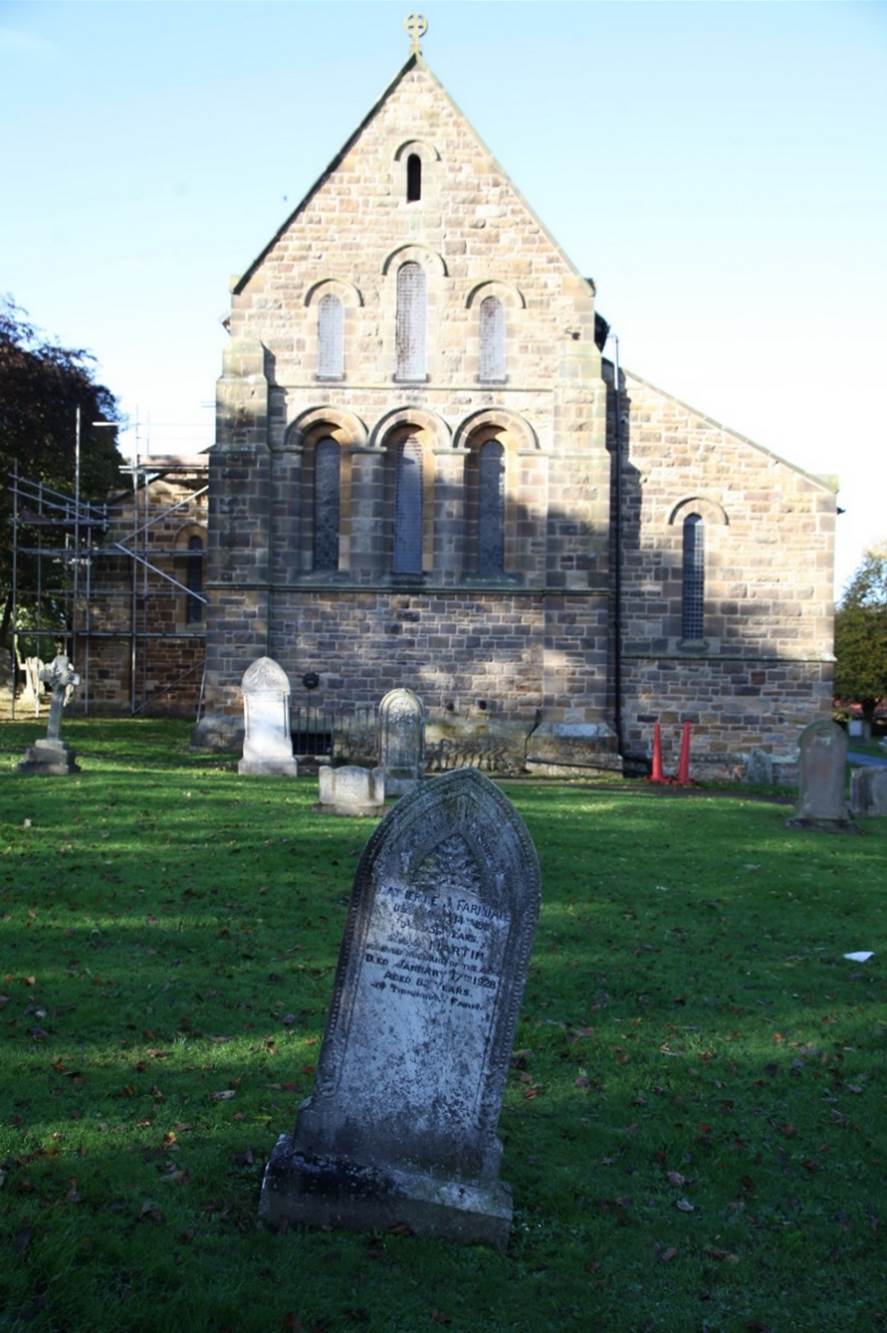
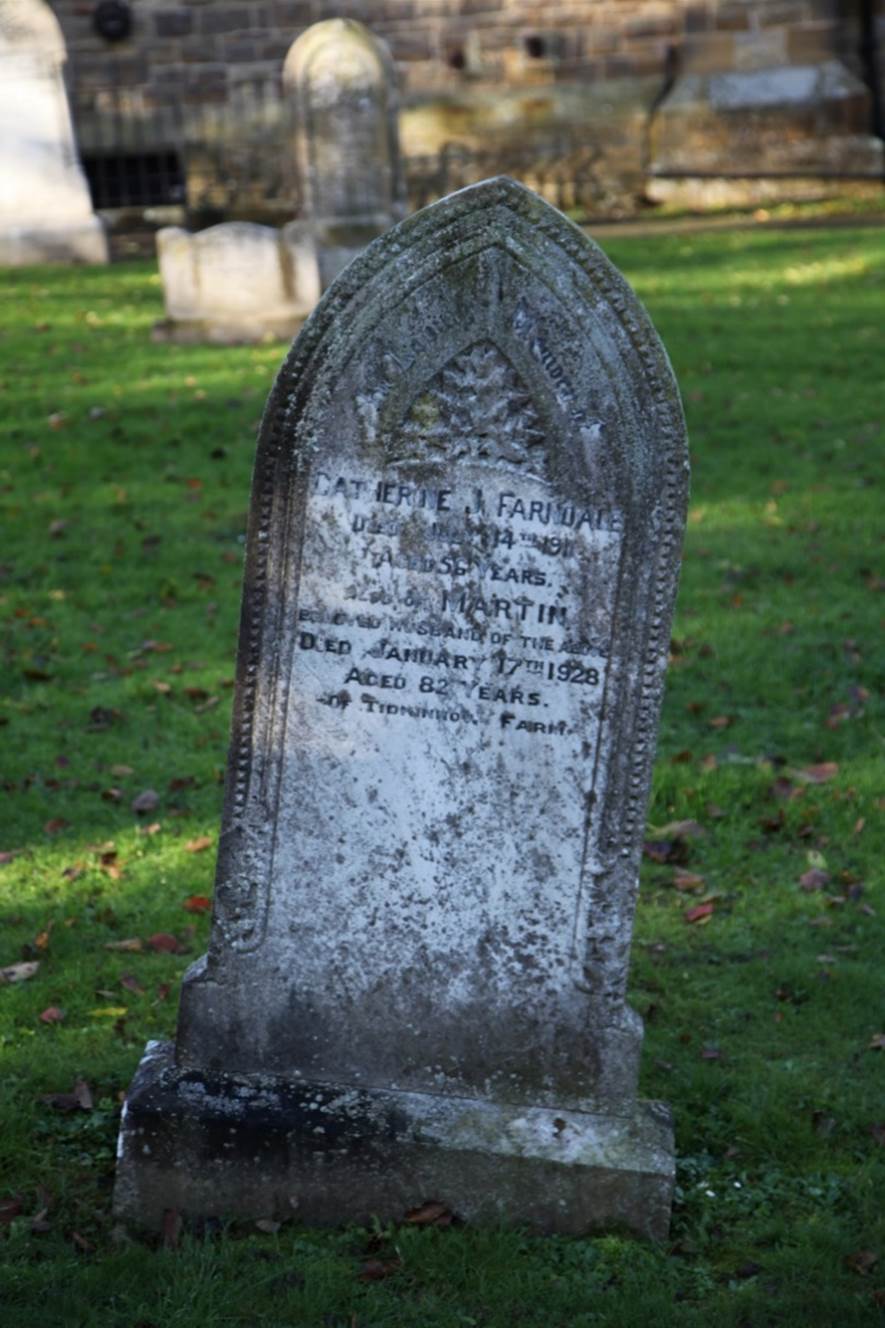
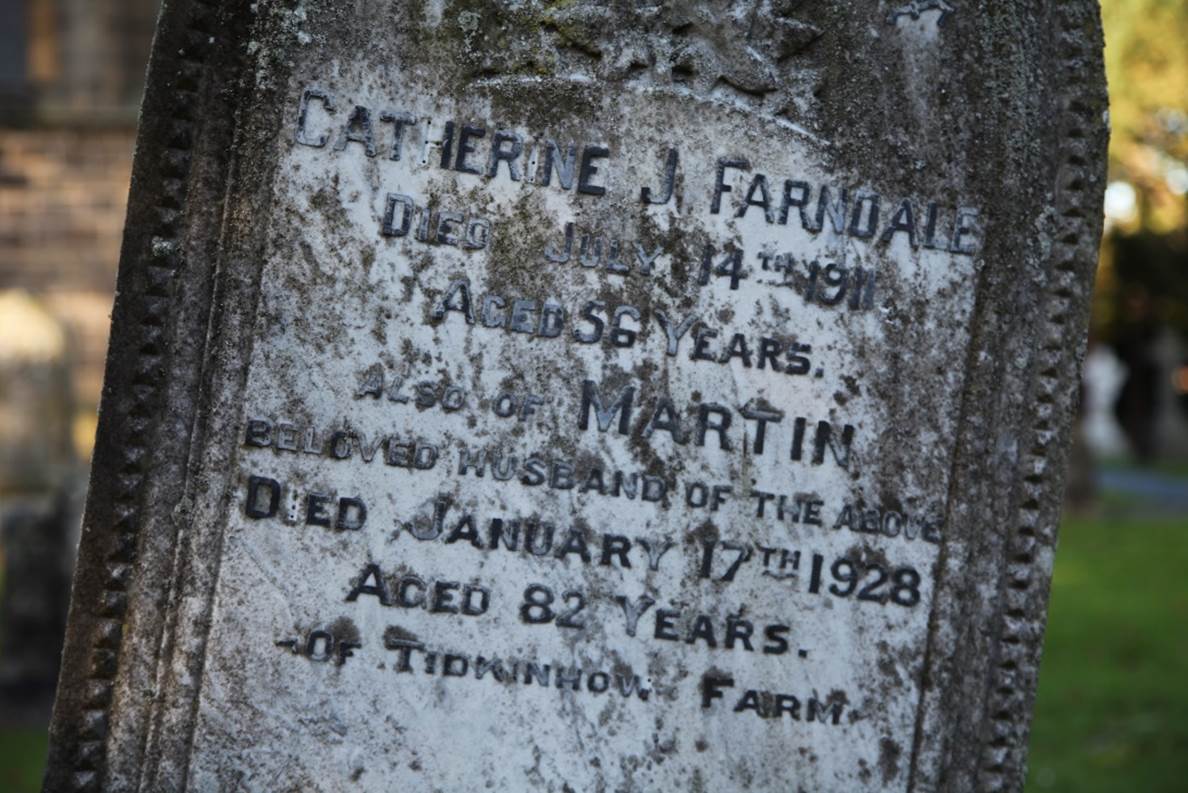
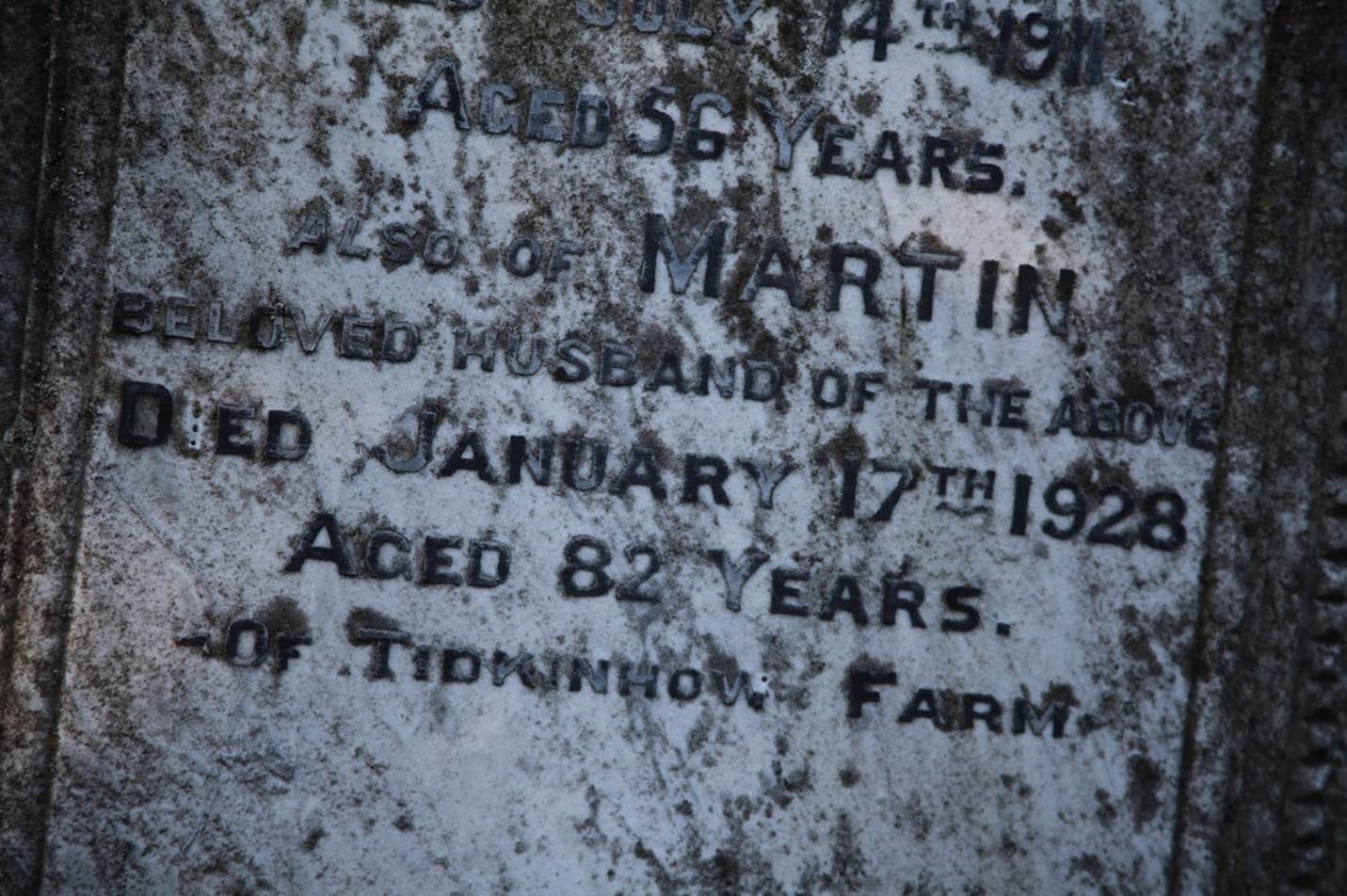
Notice
in The Official Gazette, 2 April 1929, winding up the estate: Re
MARTIN FARNDALE, Deceased. Pursuant to Statute 15 Geo V, c19. Notice is hereby
given that all creditors and other persons having any debts, claims or demands
against the estate of Martin Farndale, later Tidkinhow Farm, Boosbeck, in the
county of York, farmer, deceased, who died on the 17th day of January, 1928,
and whose will was proved in the Principal Registry of the Probate Division of
his Majesty's High Court of Justice on the second day of March, 1928, by
Elizabeth Lindsay Barker, the executrix named therein, are hereby required to
send in the particulars of their claims or demands to us, the undersigned, the
solicitors for the said executrix, on or before the 3rd day of June, 1929,
after which date the said executrix will proceed to distribute the assets of
the said deceased amongst the persons entitled thereto, having regard only to
the claims and demands of which she shall then have had notice; And she will
not be liable for the assets of the said deceased, or any part thereof, so
distributed, to any persons of whose debts, claims or demands she shall not
then have had notice. Dated this 26th day of March 1929. Buchanan Richardson
and Barugh, Town Hall, Guisborough. Solicitors for the said executrix.
FARNDALE, Martin of
Tidkinhow Farm, Boosbeck,. Yorkshire died 17 January 1928. Probate London, 2
March to Elizabeth Lindsay Barker, widow. Effects £451 15s.







